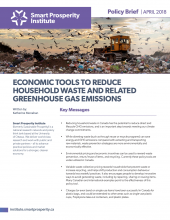April 15, 2018
The amount of household waste heading to landfills increased by 18% in Canada from 2002 to 2014. That is in contrast to our peer countries in the OECD where waste has been decreasing. Environmental pricing instruments are an important tool for helping reverse this trend.
This Policy Brief focuses on economic policy tools to encourage waste prevention and diversion at the final consumer stage.
Key Messages:
- Reducing household waste in Canada has the potential to reduce direct and lifecycle GHG emissions, and is an important step towards meeting our climate change commitments.
- While diverting waste (such as through reuse or recycle programs) can save energy and GHG emissions compared with extracting and transporting raw materials, waste prevention strategies are more environmentally and economically effective.
- Environmental pricing and economic incentives can be used to reward waste prevention, return/reuse of items, and recycling. Currently these policy tools are under-utilized in Canada.
- Variable waste collection pricing rewards households that prevent waste or increase recycling, and helps shift production and consumption behaviour towards less wasteful practices. It also encourages people to develop innovative ways to avoid generating waste, including by repairing, sharing or reusing items. Many Canadian and international examples point to the effectiveness of this policy tool.
- Charges (or even bans) on single-use items have been successful in Canada for plastic bags, and could be extended to other areas such as single-use plastic cups, Polystyrene take-out containers, and plastic plates.
- Economic incentives to reduce waste include deposit return schemes (such as for glass bottles) and financial rewards for recycling non-typical items such as batteries or electronic waste. These financial incentives can be championed and managed by producers or mandated by governments, and can be financed through small environmental fees on product sales.
- Canada has significant scope to increase the use of these environmental pricing and incentive-based instruments. In some cases, this means simply expanding the reach and scope of existing programs, or promoting best-practice standardization across Canada. This will require coordination by all levels of government – to develop an integrated policy package that rewards less wasteful practices and that ultimately cuts associated GHG emissions.
In the News:
Pay-as-you-throw fees and 4 more ways to reduce waste | CBC News




